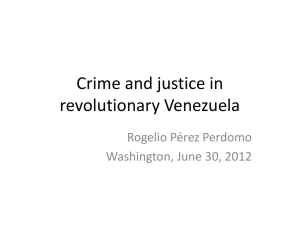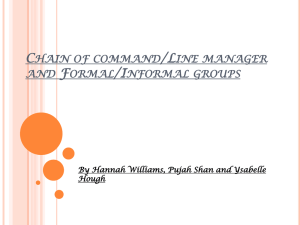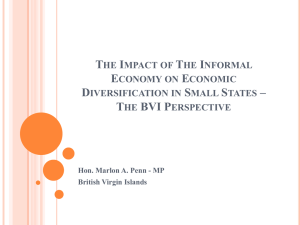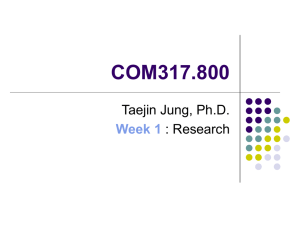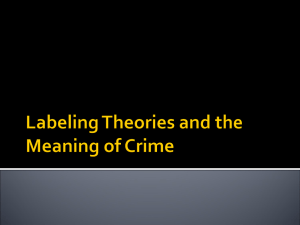Political transition and the case for informal security in Africa (Cont…)
advertisement
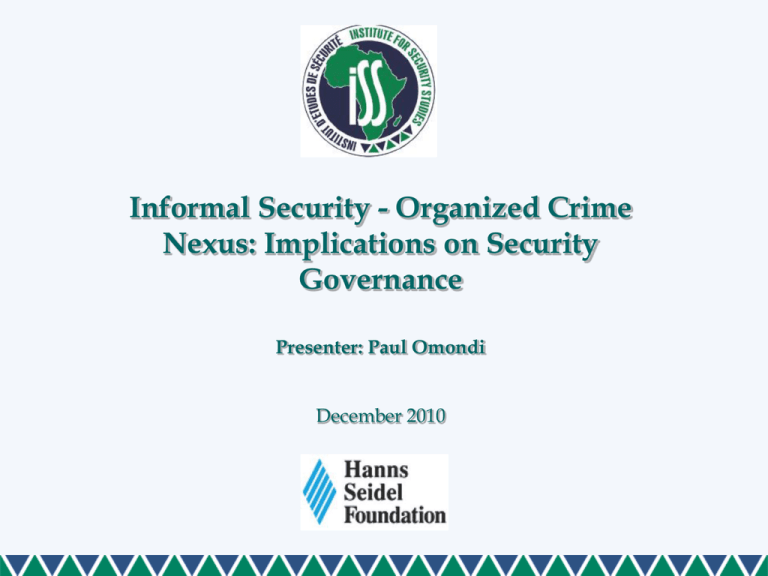
Informal Security - Organized Crime Nexus: Implications on Security Governance Presenter: Paul Omondi December 2010 Presentation Outline Introduction Interstice of informal security and organised crime Political Expediency Theory Contextualising informal security growth in Kenya Interrogating criminal justice approaches The case of South Africa Conclusion Introduction Political transition and the case for informal security in Africa The 90’s was a turning point in Africa, which saw most countries enter a new dispensation characterised by transformation in political governance. It is, however, interesting that the paradoxical outcome of the political reforms appear to provide impetus for violence and crime. The escalating insecurity also seem to make a case for increasing replacement of state security with informal security. Political transition and the case for informal security in Africa (Cont…) Key Question: “What factors inherent in the political transition process enhance susceptibility to higher levels of organised crime, and by extension the growth of informal security?” Dichotomous views are expressed: Political transition and the case for informal security in Africa (Cont…) View 1: The rise in informal security structures is linked to gaps in law enforcement. Thus, informal security have expanded to compensate for the deteriorating security conditions. View 2: “Vigilantism can not merely be explained as a popular response to the vacuum left by state collapse, failure or instrumentalised disorder" (Pratten, 2008) The focus of this presentation 1) How informal security structures interlace with organised crime 2) How the political transition correlates with the experience of organised crime 3) The best way to best way to address the proliferation of vigilantes, gangs, and militia The main focus of this paper will be on Kenya, but also draw from SA experience Interstice of informal security and organised crime Defining organised crime Four aspects define organised crime (Naylor, 1997) Have a durable hierarchical structure Employ systemic violence (or the threat of it) and corruption Obtain abnormally high rates of return relative to other criminal activities or organizations Extend their activities into the legal economy Organised crimes are characteristically 'enterprise' as opposed to 'predatory' The concept of informal security Informal security structures operate across a broad spectrum of legitimacy and sometimes have direct linkages to or are recognised by state authorities Normatively speaking, informal security structures do not necessarily constitute criminal groups, unless the concerned parties deliberately engage in wrongdoing Informal security groups have been shown to progressively transmute into illegal commercial operations, often emphasizing punishment and generating an atmosphere of fear to attain their goals What are the implications of informal security on organised crime? An empirical survey in Kenya showed that most of the informal security structures are taking advantage of the community policing project to claim legitimacy as community-based vigilante groups (South Consult, 2010) Informal security structures often possess deep fractures, which question their role, if any, within the criminal justice system. The case of 'Mungiki’ (Kenya) It is shown that the gang has well organised hierarchy Starting on the platform of ‘protection-action’, the group soon assumed character of a well-armed violent gang. It intimidate and demand varied payments, and murder those who refused to comply The group have taken control of lucrative the ‘matatu’ public transport businesses demanding 'protection money‘ The group is also engaged in other business activities, including demanding payments from car repair men Political Expediency Theory Principles of Political Expediency Theory The political expediency rests on the premise that the relationship between organised crime and politics is intrinsic The theory’s perspective assumes that organised crime infiltrates the political sphere by corruption of state officials Consequently, criminals are protected from the criminal justice by law enforcement officials “Commoditization” of violence Political Expediency Theory has been used to explain relationship between criminal or in this case informal security groups and violence It is observed that the option for those criminal groups that are unable to employ corruption is 'commoditization' of violence This speaks to the fact that an increasing number of criminal groups rely on violence as a tradeable commodity Motivations for violence among informal security / organised criminal groups Gangs engaged in survival Gangs used to disrupt opposition rallies Gang Violence Gangs defending themselves from violence by the state security forces Commoditization of violence Gangs organised to support state politicians afraid of the opposition Contextualising informal security growth in Kenya Contextualising informal security growth in Kenya With the advent of democracy, violence and crime have increasingly taken center stage The post-democracy era in Kenya has seen the expansion of the criminal economy, this largely occurring within the context of informal security structures The level of activity in organised crime is well indicated by the number of groups in operation. Government report demonstrates that there are at least 33 vigilante /criminal gang groups in the country Historical context Post democracy appeared to create an environment that was favorable to development, initially, of informal security structures. Three possibilities appear to have worked the way into this development: 1) The first factor related to historical ethno-political tensions and perceived lack of capacity for law and order policing Consequent inter-ethnic conflicts saw communities resort to self-help policing, particularly in the form of vigilante activities Historical context (Cont…) 2) The second factor related to legislative gap. The negotiation for political reforms took place in the context of legislative gaps It can be noted that, since independence, legislation in Kenya have been changed over time to buttress a strong executive at the expense of other parts of government Historical context (Cont…) 3) The third factor related to political patronage A major consequence of the democratic transition has been growing infiltration of the political sphere by informal security groups The involvement of these groups during elections suggests a tendency for them to behave as 'foot soldiers', coming together when hired to do so and forming groups to take care of the interests of local politicians Interrogating criminal justice approaches Understanding models of organised crime Three frameworks have primarily directed the theoretical lenses on criminal justice approaches. These include: The enterprise approach The alien-conspiracy/bureaucracy paradigm The patrimonial/patron-client relations perspective a) Enterprise approach Profit is the key motivation Cohesion is based on the drive to achieve self-interested goals Cooperation between the leader (s) and subordinates is maintained through voluntary subordination of the latter The leadership structure is flexible and often decentralised Law enforcement implications: Groups based on this model are susceptible to law enforcement efforts The group gets incapacitated when the money trail or financial operation is curtailed b) Alien-conspiracy paradigm Complex hierarchy and extensive division of labor to enhance efficiency Cohesion is based on firm leadership rather than on contractual arrangements Membership is of a permanent nature The groups often seek political influence as part of their operations Law enforcement implications: Groups based on this model are susceptible to law enforcement efforts The group would fall apart if the leadership is purged c) Patrimonial paradigm Has element of hierarchy Cohesion is based on emotional connection rather than rules. Emphasis is on traditions such as oaths Engage in activities beyond purely economic Extend influence into the worlds of legitimate government and business Law enforcement implications: Groups based on this model are very stubborn to law enforcement efforts Continuity is ensured even when the leader purged Anatomy of organised crime in Kenya There are strong inclinations, at least in Kenya, to cluster along two models, albeit interlocking: - 'patrimonial - enterprise' - ‘alien-conspiracy - enterprise‘ As discerned, ‘profit motive’ remains an imperative denominator in explanation of violent behavior among criminal groups. “Patrimonial – Enterprise” paradigm Notable features that deserve attention include: Ethno-cultural identity Infiltration into the political and law enforcement spheres Extension into legitimate business Defiance to law enforcement measures Instructive cases include: 'Mungiki, Chinkororo, Taliban, and Kaya Bombo Youth' “Alien-conspiracy – Enterprise” paradigm Notable features that deserve attention include: Hierarchical attributes akin to those found in the military Appear to have political aspirations and an interest in changing the social status quo Quite susceptible to law enforcement measures Instructive cases include: ’Sabaot Land Defense Force’ and ‘Angola Msumbiji’ A closer look at criminal justice approach in Kenya The transition era policing reforms involved refocus of the functions of the hitherto 'political police unit' (known as Special Branch) to national security surveillance The mainstream police failed to radically change with the new dispensation The nature of police response to the threat of organised crime have largely remained within the 'old school' law enforcement paradigm, which entail vigorous law enforcement interventions involving use of 'raw' force A closer look at criminal justice approach in Kenya (Cont…) Previous police initiatives to impede organised crime became subject to criticism The mainstream police failed to radically change with the new dispensation For example: In responding to the menace of 'Mungiki', the Kenya Police task force known as 'Kwe - Kwe squad' was formed The task force was largely associated with extra-judicial killings A closer look at criminal justice approach in Kenya (Cont…) At another level, the scope and nature of police complicity and modus operandi has seriously put to question the capability of criminal justice system Three areas are isolated as essential and in need of address: accountability, professionalism, and efficiency The Case of South Africa The context of informal security structures in SA Private policing has become a prevalent feature of the SA security landscape But while private policing is increasingly asserting its position in the country, the unfortunate reality is that they "provide a ready base from which violent vigilante actions can grow" Precipitating factors for growth of informal security structures Development of private policing can mainly be located within the Apartheid era security governance system From security governance perspective, skewed law enforcement saw a large number of autonomous groups that arose to deal with township crime, frustrated that the state police did so little to protect their residents or investigate crime From socio-political perspective, the focus is on profound experience of factional violence that characterised the transition era From law enforcement perspective, the focus is on infiltration of the law enforcement sector - the issue of corruption sticking out Precipitating factors for growth of informal security structures (Cont…) Thus, To a great extent, the continual growth of private policing is based on lower confidence on the state policing system On the other hand, community policing although considered a crucial platform for police – community partnerships, appeared to have started on a wrong footing Hence, the application of community policing also seems to have set ground for 'traps' that have precipitated the growth of ‘state sanctioned’ vigilantism Conclusion In summary … This discussion shows that there are tendencies for the practice of organised crime to revolve around informal security structures It is apparent that the governance system - comprising political and law enforcement structures, constitute a key dynamic in the propagation of organised criminal groups Initiatives on security sector reforms and legislations are an affirmation of recognition of these dynamics. The focus of these measures, however, seems to be on insulating the law enforcement but paying scant attention to the political relations Action points 1. Enhancing capability of law enforcement agencies in security intelligence is a critical factor to understand the patterns of existing criminal groups and to prevent formation of new ones 2. Accountability in political system: The increasing infiltration of political sphere by illicit groups has facilitated of organised crime. Vetting of individuals seeking political positions is essential 3. Accountability in Criminal justice system: Public trust underlines the credibility of criminal justice institutions. There must be measures to ensure high levels of integrity. Action points (Cont…) 4. Community-based policing: Community-based policing is broadly recognised as essential to partnership between law enforcement agencies and communities to address community concerns, and in establishing police accountability. It is however also recognised that most informal security structures have started on this platform. Their accountability rests on how well they are regulated 5. Anti-corruption measures: Tough anti-corrupt measures are necessary for two purposes: First, to incapacitate the money trails which sustain their operations, and second, to enable the law enforcement agencies to effectively detect, investigate and prosecute crime cases. Action points (Cont…) 6. Independent police oversight: One important recommendation was the need to establish impartial and independent police oversight. The oversight body should not only be able to investigate complaints, but also be empowered to follow up recommendations. 7. Alternative livelihood: Security governance solutions have to take cognizance of the reality of existence of the criminal groups, complex as it may be. Reaching out to the militia with the aim of reintegrating them into the community may therefore not be an option.


